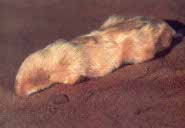 The Marsupial Mole (Notoryctes typhlops) is a mole-like marsupial that evolved to its environment in Australia, and amazingly it is much like the Eutheria (placental mammal) mole. It is a very rare creature, seldom seen, and there are only two known species, however there could possibly be more. Exact data and numbering, along with information on whether or not it is endangered is unfortunately not available at this time, due to the difficulty in tracking them. They have evolved to forego the use of their eyes, and they only have small lenses in the skin where their eyes would have gone. Furthermore they have only two small holes where their ears are, and may have limited hearing.
The Marsupial Mole (Notoryctes typhlops) is a mole-like marsupial that evolved to its environment in Australia, and amazingly it is much like the Eutheria (placental mammal) mole. It is a very rare creature, seldom seen, and there are only two known species, however there could possibly be more. Exact data and numbering, along with information on whether or not it is endangered is unfortunately not available at this time, due to the difficulty in tracking them. They have evolved to forego the use of their eyes, and they only have small lenses in the skin where their eyes would have gone. Furthermore they have only two small holes where their ears are, and may have limited hearing. Normally when caught or found, they weigh between 40-70 grams and have a length of around 5-6 inches. Additional to that length is their one inch bald tail. Their forepaws are highly specialized for digging and for burrowing, as they are shaped somewhat like shovels. The fur of the marsupial mole is very soft and silk like, while being of a golden color and helps when moving through sand, while their claws are very sharp, and their pouch is facing the opposite direction that it would normally face - so that dirt does not gather in it. They eat larva primarily and burrow constantly - without ever leaving the ground.
Controversial
The marsupial mole was a controversial subject for a while, originally thought to be eutheria (placental mammals, lacking pouches) due to an early specimen that had degraded and decomposed badly on a trip from Australia to England. It was later found that they are indeed a marsupial, and not the missing link between marsupials and eutherias, however it has now come to light that they are not related to the largest group of marsupials, and have since been given their own order, Notoryctemorphia. In this order there is only one family, Notoryctidae, and one genus, Notoryctes. There are thought to be, at this time, two species of marsupial moles. One from the north called the Northern Marsupial Mole, and one from the south called the Southern Marsupial Mole. They are closely related and no real distinguishing marks exist when compared to each other, and they may not be wholly different species at all.
Behavior and mating habits are universally unknown due to their short life in captivity, but it is assumed that they are solitary during most of the year and use their highly developed sense of smell to find a mate. Although the ear seems under developed, it could be seen as having a highly adapted middle ear that could allow for underground communication, as the marsupial mole does make a high pitched noise when removed from the ground or disturbed. It is thought the sound can travel under ground for a decent distance.
Some interesting facts about marsupial moles:
- The marsupial mole spends most of its time 1-10 centimeters below the surface on average.
- When burrowing, the marsupial mole burrows straight down at random times, going as far as three meters for no apparent reason.
- The marsupial mole has a highly unusual body temperature management, and it can change in the extreme, from 15-30°C (59-86 Fahrenheit), but does not seem to affect its metabolism.
- When at rest the metabolism of the marsupial mole is very low, however when it burrows it can increase up to sixty times, providing a large burst of energy and activity.
Picture of the marsupial mole by Bartus.malec, licensed under GFDL
The Marsupial mole, southern marsupial mole is listed as Endangered (EN), considered to be facing a very high risk of extinction in the wild, on the IUCN Red List of Threatened Species
Namings for the marsupial mole
A young / baby of a marsupial mole is called a 'pup'. A marsupial mole group is called a 'labour,company or movement'.Countries
Australia
Custom Search